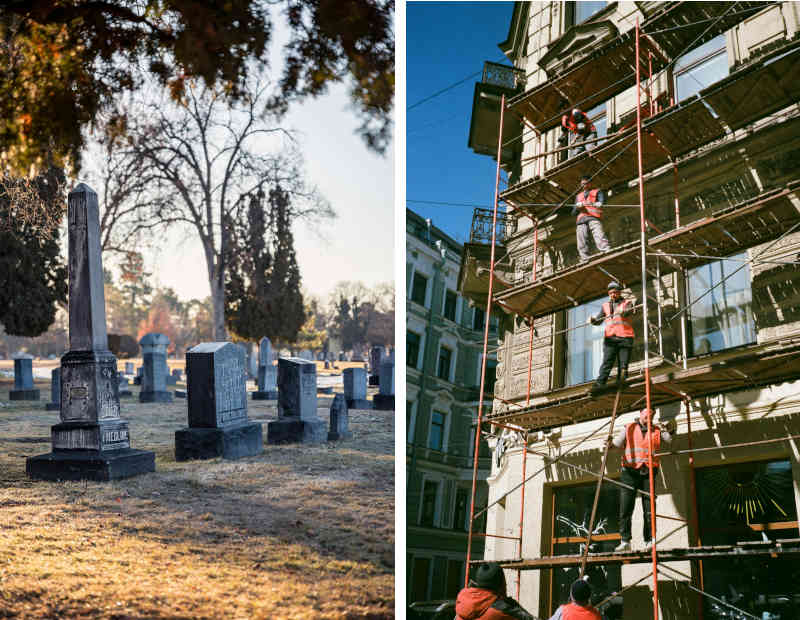In most first world countries, church attendance has been falling for decades (for some numbers, see note).
But does this mean the church is dying in those countries, or taking new forms?
Is religious belief in decline, or is it too taking new forms?
“The church isn’t dying. It’s being remade”
I came across an article with this title on the Faith & leadership website. It argues that, in the US at least, the 1950s model of church is in decline, but new ways of being the church are being developed.
The author, Shannon Hopkins, points out that the patterns of church we are familiar with (set apart “holy” buildings, Sunday services led by a professional priest or pastor, sermons and rituals, etc) were developed long ago in a very different culture. “Modern life is different. Work is different; dating, community life, technology — they’re all different. So shouldn’t church be different as well?”
She mentions a whole range of new ways of being a church or of using church buildings:
- Breweries and bakeries in old church buildings.
- Selling or donating church buildings to worthwhiloe causes, including social housing and returning property to indigenous groups in New York and Denver.
- Use of church facilities (kitchens or room space) for small businesses, community building or social welfare groups.
- Conversion of facilities into social housing, affordable housing for seniors, childcare for the working poor, a community cafe, and economic development in struggling neighbourhoods (e.g. shower and laundry facilities for homeless people).
- Offering training and help on financial management, immigration assistance.
- Partnership schemes providing food accessibility (creating “an ecosystem for spiritual joy and social justice”), tiny homes for the homless or working poor, and rehearsal space to the theater community – and rental income for the church.
- Getting involved in local communities, via farmer’s markets (and an associated dinner church), wildlife preservation and native plant gardens, and community development programs.
Organisations have grown up to assist in some of these activities:
- Oikos Institute for Social Impact specifically helps black churches and groups to engage with their communities to “harness the power of their assets in order to be a catalyst for communal transformation and economic renewal.”
- The Missional Wisdom Foundation helps people and spiritual communities live according to a rule of life which “opens our eyes to God’s grace, balances our lives, and enables us to pursue holiness in all aspects of daily living.” These groups are active in one or more of the areas set out above.
So it may be that many Christians are serving and meeting in new ways that may not always be recognised as churches.
It is also worth noting that many Chriostians these days are “:done” with the more traditional structures and forms of church, and choosing to meet in smaller informal groups. (Expect a post on these soon.) So declining attendance isn’t always declining belief.
A wide range
Some of these activities are simply secular re-use of a former church building, which is better than leaving it idle, but not really building the church or serving the poor.
But others are run by Christian organisations with a social or spiritual purpose, and some are activities of a current church. They generally have a positive impact in the community, and may lead to new people choosing to follow Jesus and join the church or group.
Is it growing the church?
This is a legitimate question. Are all these activities growing the church? The answer seems to be that, generally, they are achieving very little growth, so far at least.
But perhaps that is the wrong question. A more important question is surely ….
Is it growing the kingdom of God?
If we define the kingdom of God as those who have chosen to be disciples of Jesus and are seeking to live in the way that he taught us (e.g. in the Sermon on the Mount), then our assessment may be different.
Neighbours are being loved in most of these new activities. The poor and suffering are being cared for. In many cases people are participating in spiritual Christian communities. Some good things are happening.
Furthermore, these community services are helping to create a better public opinion of the church, at least partly undoing the sad picture of a church embroiled in promiscuity, abuse, self-seeking, greed and violent patriotism. We know that isn’t a totally fair picture, but it is the way many people see the church.
But is that enough?
The church is called to love God, love neighbour and make disciples. It is only one generation away from oblivion.
So I can’t help feeling that we need to see a threefold approach to change – better ways to love God, better ways to love neightbour, and better ways to make disciples.
I believe these many new activities and ideas are a great first step. Some of them are already working on a threefold approach. But others may still have some way to go.
And it concerns me slightly that many of these new initiatives come from smaller churches, many in decline, and in a sense desperate. It is so good that they are willing to think outside the square, but it would be great if more large churches joined in. Of course some do, but we need more.
Getting on the road
Shannon Hopkins offers 5 pieces of advice for those looking to try something new:
- Don’t look back. Nostalgia won’t help, embrace the future!
- Lament. Grieve what is being lost (perhaps even have special ceremonies to do this), then move forwards.
- Experiment. Try new ideas as a learning exercise and assess them before committing.
- Serve. Make justice a priority, listen, learn and try to understand the needs of neighbours and others, then look for ways to serve those needs.
- Be open to surprise. Who knows what God might do?
What is the essence?
Is there a core philosophy behind these disparate approaches?
I haven’t seen a definitive statement, but I’m thinking these initiatives generally contain the following elements:
- Be willing to change, to innovate. Staying the same will mostly lead to going backwards.
- Look outwards, not inwards. Start with our threefold mission of love God, love neighbour and make disciples.
- Make justice a priority. Serve those who are disadvantaged and struggling. This is worth doing in itself, is obedient to Jesus and pleases God. So it is also loving God. And it may lead to making disciples.
- Get to know our neighbours. Assess the particular needs in the church’s neighbourhood, then pray about how the church might meet some of those needs.
- Don’t necessarily expect the people we serve to come into the regular Sunday services. These may not be suitable to them. But there are other ways that the church may offer spiritual encouragement and fellowship – via community based microchurches, missional communities or spiritual formation.
- Many churches are asset rich and income poor. It is possible to “leverage” their assets to create income and mission and service opportunities.
Where might this work?
All of this is happening in the US. What about elsewhere?
Some similar new groups and activities are happening in the UK, under the broad name of “Fresh Expressions“. And there are Fresh Expressions movements in other western countries too. There are critics of this movement, who fear it is compromising some aspects of ther gospel, and others who feel the church in Australia has erred in not pursuing these approaches more.
My feeling is that there is a little truth on both sides. The church does need to work out new ways to fulfil its mission, but some of the new ways may sacrifice too much.
But the need is there in all western countries, and it is too important to be left to small struggling congregations. Large successful congregations could be doing more to develop new missional initiatives aliongside their more established activities.
Note on attendance statistics
In Australia, attendances were falling for years (about 10% in the last decade of the 20th century) but began to rise slightly before Covid, and have now levelled off.
In the US, weekly attendance has almost halved in 20 years while the number of people who attend at least monthly has stayed fairly constant.
In the UK, Church of England attendances more than halved in the 30 years pre-Covid (from about 37% to about 17%), dropped further during Covid but have now risen to close to pre-Covid levels. Attendances in other denominations haven’t changed much in that period.
Elsewhere in Europe, monthly attendances vary from less than 10% in some countries (e.g. Belgium, Czech Republic) to more than 20% in others. Surprisingly, in countries with low levels of religious belief, younger people are more likely to attend than older people.
Worldwide Christian attendance statistics are harder to obtain. Some countries (e.g. South Africa, Brazil) have much higher levels of religious observance, but Christianity is a small minority in other countries.
Important note: Figures in different surveys can’t always be directly compared – some use weekly attendance, others use monthly; some use people’s self-reporting while others use actual counts at services (which generally gives much lower numbers); some service measure attendance at Christian services, but others measure all religious obervance.
Main graphic: Cemetery photo by Brett Sayles. Construction site photo by Darya Sannikova.

Too much the same?
Many Christians are really comfortable with the familiar, but is it keeping the church from its mission?

The church of the future?
If the church of the present isn’t cutting it in the postmodern world, what might the church of the future look like?

True stories
Check out these accounts of christians doing something new, something inspiring, something that points a way forward for the church.

Leave a Reply